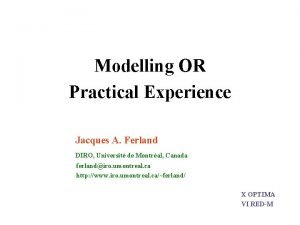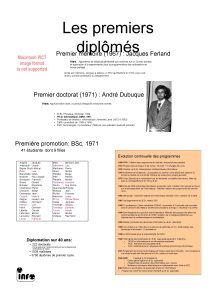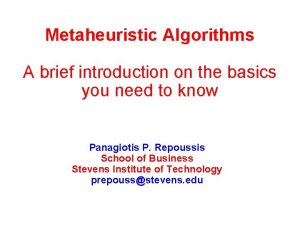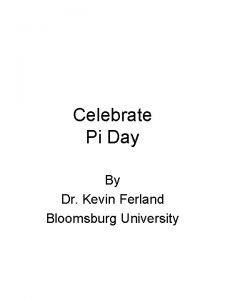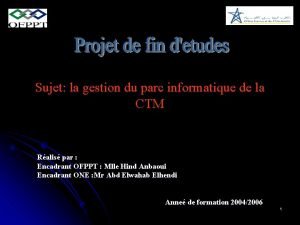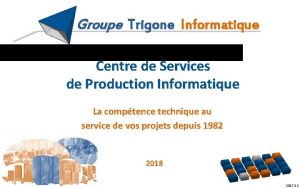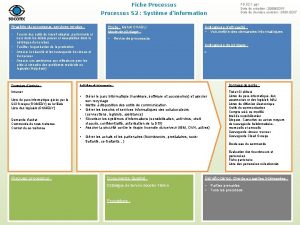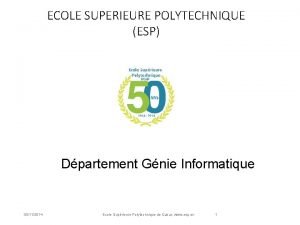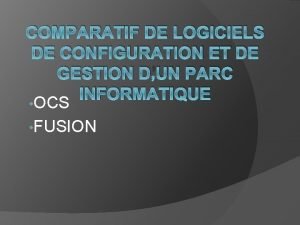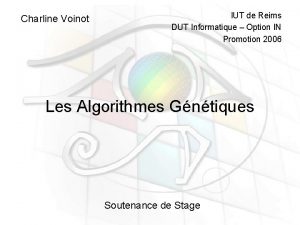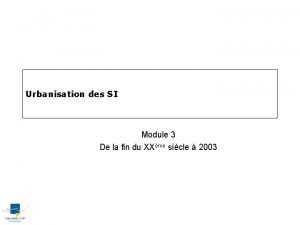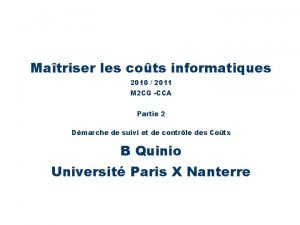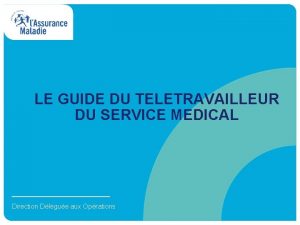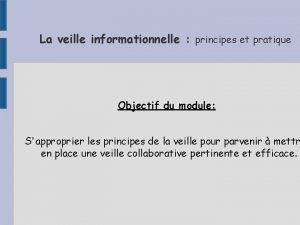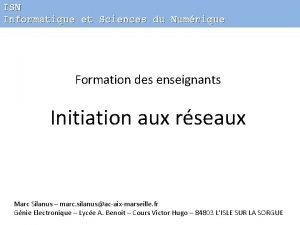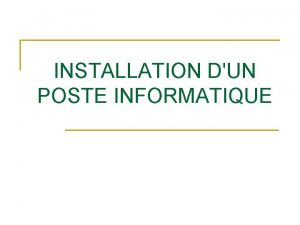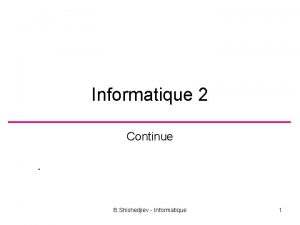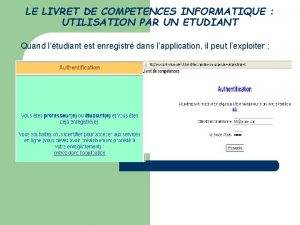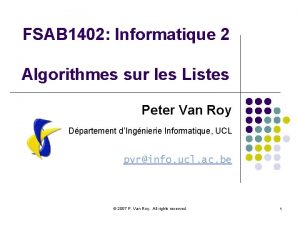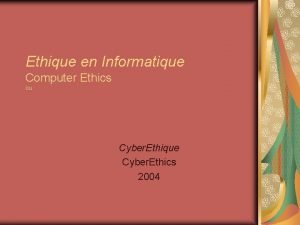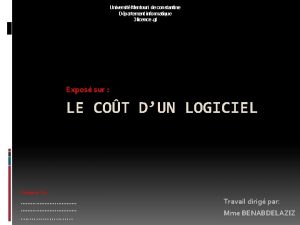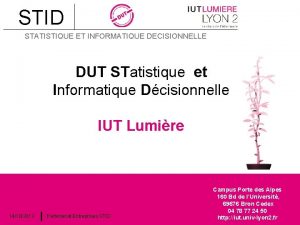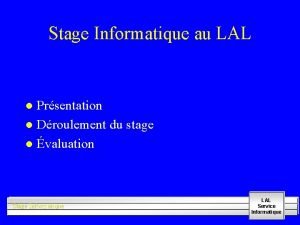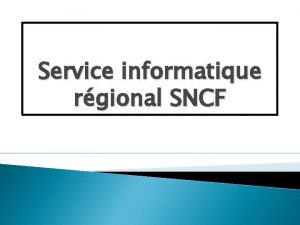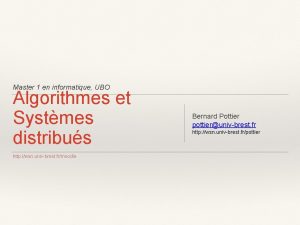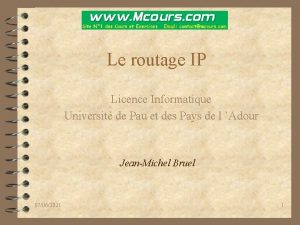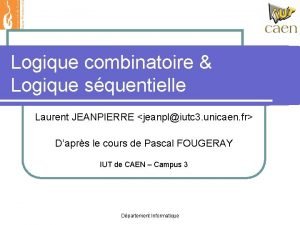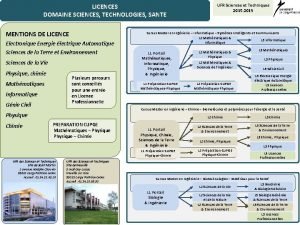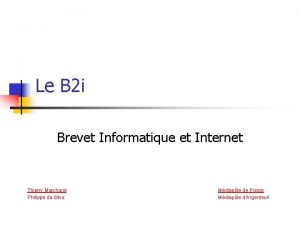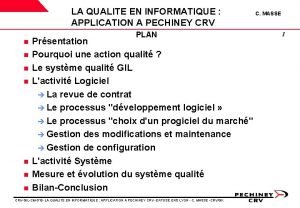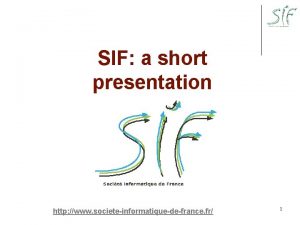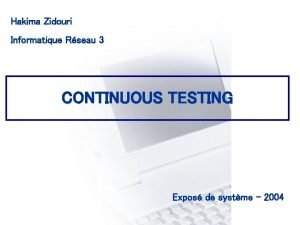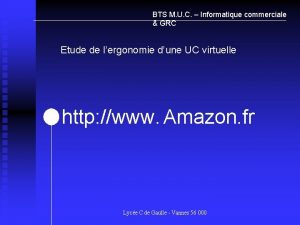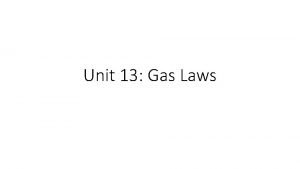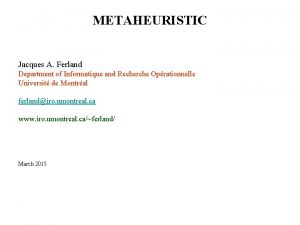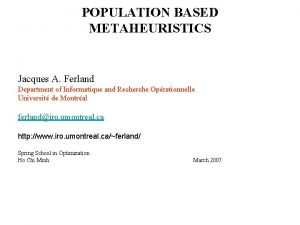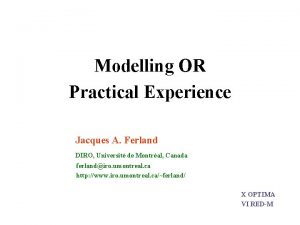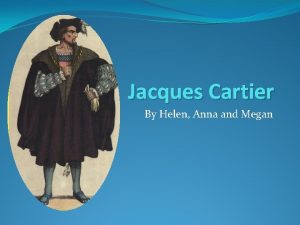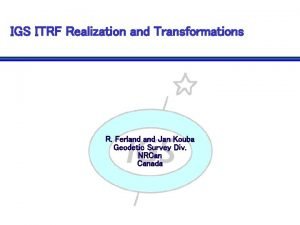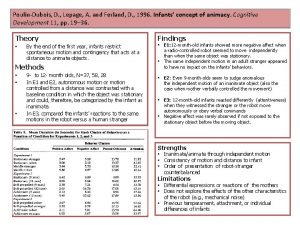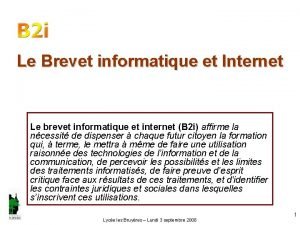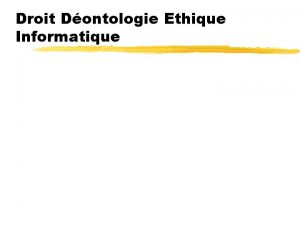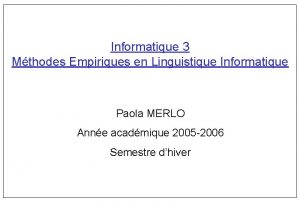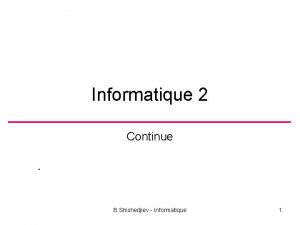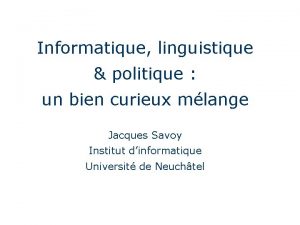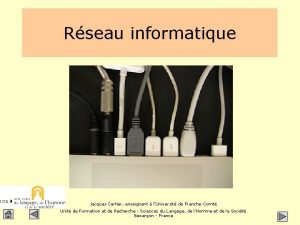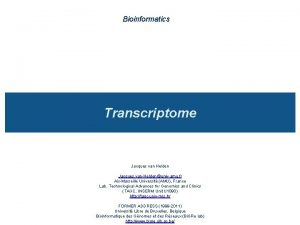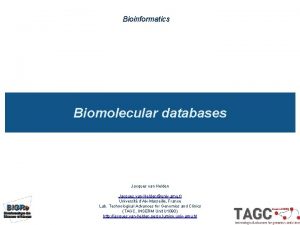METAHEURISTIC Jacques A Ferland Department of Informatique and




















































- Slides: 52

METAHEURISTIC Jacques A. Ferland Department of Informatique and Recherche Opérationnelle Université de Montréal ferland@iro. umontreal. ca March 2015

Overview • Heuristic Constructive Techniques: Generate a good solution • Local (Neighborhood) Search Methods (LSM): Iterative procedure improving a solution • Population-based Methods: Population of solutions evolving to mimic a natural process

Population-based Methods • • Genetic Algorithm (GA) Hybrid GA-LSM Genetic Programming (GP) Adaptive Genetic Programming (AGP) Scatter Search (SS) Ant Colony Algorithm (ACA) Particle Swarm Optimiser (PSO)

Genetic Algorithm (GA) • Population based algorithm • At each generation three different operators are first applied to generate a set of new (offspring) solutions using the N solutions of the current population P: selection operator: selecting from the current population parent-solutions that reproduce themselves crossover (reproduction) operator: producing offspring-solutions from each pair of parent-solutions mutation operator: modifying (improving) individual offspring-solution • A fourth operator (culling operator) is applied to determine a new population of size N by selecting among the solutions of the current population and the offspring-solutions according to some strategy

Two variants of GA • At each generation of the Classical genetic algorithm: • At each generation of the Steady-state population genetic algorithm: - N parent solutions are selected and paired two by two - An even number of parent-solutions are selected and paired two by two - A crossover operator is applied to each pair of parent-solutions according to some probability to generate two offspring-solutions. Otherwise the two parent-solutions become their own offspring-solutions - A crossover operator is applied to each pair of parent-solutions to generate two offspring-solutions. - A mutation operator is applied according to some probability to each offspring-solution. - The population of the next generation includes the offspring-solutions -The population of the next generation includes the N best solutions among the current population and the offspringsolutions

Problem used to illustrate • General problem • Assignment type problem: Assignment of resources j to activities i

Encoding the solution • The phenotype form of the solution x є ℝp is encoded (represented) as a genotype form vector z є ℝn (or chromozome) where m may be different from n. • For example in the assignment type problem: let x be the following solution: for each 1≤ i ≤ n, xij(i) = 1 xij = 0 for all other j x є ℝnxm can be encoded as z є ℝn where zi = j(i) i = 1, 2, …, n i. e. , zi is the index of the resource j(i) assigned to activity i

Genetic Algorithm (GA) • Population based algorithm • At each generation three different operators are first applied to generate a set of new (offspring) solutions using the N solutions of the current population P: selection operator: selecting from the current population parent-solutions that reproduce themselves crossover (reproduction) operator: producing offspring-solutions from each pair of parent-solutions mutation operator: modifying (improving) individual offspring-solution • A fourth operator (culling operator) is applied to determine a new population of size N by selecting among the solutions of the current population and the offspring-solutions according to some strategy

Selection operator • This operator is used to select an even number (2, or 4, or …, or N) of parent-solutions. • Each parent-solution is selected from the current population according to some strategy or selection operator. • Note that the same solution can be selected more than once. • The parent-solutions are paired two by two to reproduce themselves. • Selection operators: Random selection operator Proportional (or roulette whell) selection operator Tournament selection operator Diversity preserving selection operator

Random selection operator • Select randomly each parent-solution from the current (entire) population • Properties: Very straightforward Promotes diversity of the population generated

Proportional (Roulette whell) selection operator • Each parent-solution is selected as follows: i) Consider any ordering of the solutions z 1, z 2, …, z. N in P ii) Select a random number α in the interval For the problem min f (x) [0, ∑ 1≤k≤ N ( 1 / f( zk) )] where x is encoded as z iii) Let τ be the smallest index such that 1/f (z) measures ∑ 1≤k≤ τ (1 / f( zk ) ) ≥ α the fittness of the τ iv) Then z is selected solution z 1 / f( z 1 ) | | 1 / f( z 2 ) 1 / f( z 3) | | τ 1 / f( z. N) … | | α The chance of selecting zk increases with its fittness 1 / f( zk)

Tournament selection operator • Each parent-solution is selected as the best solution in a subset of randomly chosen solutions in P: i) Select randomly N’ solutions one by one from P (i. e. , the same solution can be selected more than once) to generate the subset P’ ii) Let z’ be the best solution in the subset P’: z’ = argmin z є P’ f(z) iii) Then z’ is selected as a parent-solution

Elitist selection • The main drawback of using elitist selection operator like Roulette whell and Tournament selection operators is premature converge of the algorithm to a population of almost identical solutions far from being optimal. • Other selection operators have been proposed where the degree of elitism is in some sense proportional to the diversity of the population.

Genetic Algorithm (GA) • Population based algorithm • At each generation three different operators are first applied to generate a set of new (offspring) solutions using the N solutions of the current population P: selection operator: selecting from the current population parent-solutions that reproduce themselves crossover (reproduction) operator: producing offspring-solutions from each pair of parent-solutions mutation operator: modifying (improving) individual offspring-solution • A fourth operator (culling operator) is applied to determine a new population of size N by selecting among the solutions of the current population and the offspring-solutions according to some strategy

Crossover (recombination) operators • Crossover operator is used to generate new solutions including interesting components contained in different solutions of the current population. • The objective is to guide the search toward promissing regions of the feasible domain X while maintaining some level of diversity in the population. • Pairs of parent-solutions are combined to generate offspringsolutions according to different crossover (recombination) operators.

One point crossover • The one point crossover generates two offspring-solutions from the two parent-solutions z 1 = [ z 11, z 21, …, zn 1] z 2 = [ z 12, z 22, …, zn 2] as follows: i) Select randomly a position (index) ρ, 1 ≤ ρ ≤ n. ii) Then the offspring-solutions are specified as follows: oz 1 = [ z 11, z 21, …, zρ1, zρ+12, …, zn 2] oz 2 = [ z 12, z 22, …, zρ2, zρ+11, …, zn 1] Hence the first ρ components of offspring oz 1 (offspring oz 2) are the corresponding ones of parent 1 (parent 2), and the rest of the components are the corresponding ones of parent 2 (parent 1)

Two points crossover • The two points crossover generates two offspring-solutions from the two parent-solutions z 1 = [ z 11, z 21, …, zn 1] z 2 = [ z 12, z 22, …, zn 2] as follows: i) Select randomly two positions (indices) μ, ν, 1 ≤ μ ≤ ν ≤ n. ii) Then the offspring-soltions are specified as follows: oz 1 = [ z 11, …, zμ-11, zμ 2, …, zν 2, zν+11, …, zn 1] oz 2 = [ z 12, …, zμ-12, zμ 1, …, zν 1, zν+12, …, zn 2] Hence the offspring oz 1 (offspring oz 2) has components μ, μ+1, …, ν of parent 2 (parent 1), and the rest of the components are the corresponding ones of parent 1 (parent 2)

Uniform crossover • The uniform crossover requires a vector of bits (0 or 1) of dimension n to generate two offspring-solutions from the two parent-solutions z 1 = [ z 11, z 21, …, zn 1] , z 2 = [ z 12, z 22, …, zn 2] : i) Generate randomly a vector of n bits, for example [0, 1, 1, 0, …, 1, 0] ii) Then the offspring-solutions are specified as follows: parent 1: [ z 11, z 21, z 31, z 41, …, zn-11, zn 1] parent 2: [ z 12, z 22, z 32, z 42, …, zn-12, zn 2] Vector of bits: [ 0 , 1 , 0 , …, 1 , 0 ] Offspring oz 1 : [ z 11, z 22, z 32, z 41, …, zn-12, zn 1] Offspring oz 2: [ z 12, z 21, z 31, z 42, …, zn-11, zn 2]

Uniform crossover • The uniform crossover requires a vector of bits (0 or 1) of dimension m to generate two offspring-solutions from the two parent-solutions z 1 = [ z 11, z 21, …, zn 1] , z 2 = [ z 12, z 22, …, zn 2] : i) Generate randomly a vector of bits, for example [0, 1, 1, 0, …, 1, 0] ii) Then the offspring-solutions are specified as follows: parent 1: [ z 11, z 21, z 31, z 41, …, zn-11, zn 1] Hence the ith component of oz 1 parent 2: [ z 12, z 22, z 32, z 42, …, zn-12, zn 2] (oz 2) is the ith component of parent 1 (parent 2) if the ith Vector of bits: [ 0 , 1 , 0 , …, 1 , 0 ] component of the vector of bits is 0, otherwise, it is equal to the ith component of parent 2 1 1 2 2 1 Offspring oz : [ z 1 , z 2 , z 3 , z 4 , …, zn-1 , zn ] (parent 1) Offspring oz 2: [ z 12, z 21, z 31, z 42, …, zn-11, zn 2]

Path relinking • The path relinking procedure generates a sequence of feasible solutions along a path linking two solutions x 1 and x 2











Ad hoc crossover operator The preceding crossover operators are sometimes too general to be efficient. Hence, whenever possible, we should rely on the structure of the problem to specify ad hoc problem dependent crossover operator in order to improve the efficiency of the algorithm.

Recovery procedure Furthermore, whenever the structure of the problem is such that the offspring-solutions are not necessarily feasible, then an auxiliary procedure is required to recover feasibility. Such a procedure is used to transform the offspring-solution into a feasible solution in its neighborhood.

Genetic Algorithm (GA) • Population based algorithm • At each generation three different operators are first applied to generate a set of new (offspring) solutions using the N solutions of the current population P: selection operator: selecting from the current population parent-solutions that reproduce themselves crossover (reproduction) operator: producing offspring-solutions from each pair of parent-solutions mutation operator: modifying (improving) individual offspring-solution • A fourth operator (culling operator) is applied to determine a new population of size N by selecting among the solutions of the current population and the offspring-solutions according to some strategy

Mutation operator • Mutation operator is an individual process to modify offspring-solutions • In traditional variants of Genetic Algorithm the mutation operator is used to modify arbitrarely each componenet zi with a small probability: For i = 1 to n Generate a random number β [0, 1] If β < βmax then select randomly a new value for zi where βmax is small enough in order to modify zi with a small probability • Mutation operator simulates random events perturbating the natural evolution process • Mutation operator not essential, but the randomness that it introduces in the process, promotes diversity in the current population and may prevent premature convergence to a bad local minimum



Genetic Algorithm (GA) • Population based algorithm • At each generation three different operators are first applied to generate a set of new (offspring) solutions using the N solutions of the current population P: selection operator: selecting from the current population parent-solutions that reproduce themselves crossover (reproduction) operator: producing offspring-solutions from each pair of parent-solutions mutation operator: modifying (improving) individual offspring-solution • A fourth operator (culling operator) is applied to determine a new population of size N by selecting among the solutions of the current population and the offspring-solutions according to some strategy

Hybrid Methods • This is a good strategy since it is well known that in general, Genetic Algorithms GA(and population based algorithms in general) are very time consuming and generate worse solutions than LSM • Strength of hybrid methods comes from combining complementary search strategy to take advantage of their respective strength. For instance, - Intensify the search in a promissing region with the LSM - Diversify the search through the selection operator, crossover operator of the GA



Genetic Algorithm (GA) • Population based algorithm • At each generation three different operators are first applied to generate a set of new (offspring) solutions using the N solutions of the current population P: selection operator: selecting from the current population parent-solutions that reproduce themselves crossover (reproduction) operator: producing offspring-solutions from each pair of parent-solutions mutation operator: modifying (improving) individual offspring-solution • A fourth operator (culling operator) is applied to determine a new population of size N by selecting among the solutions of the current population and the offspring-solutions according to some strategy

Genetic Algorithm (GA) • Population based algorithm • At each generation three different operators are first applied to generate a set of new (offspring) solutions using the N solutions of the current population P: selection operator: selecting from the current population parent-solutions that reproduce themselves crossover (reproduction) operator: producing offspring-solutions from each pair of parent-solutions mutation operator: modifying (improving) individual offspring-solution • A fourth operator (culling operator) is applied to determine a new population of size N by selecting among the solutions of the current population and the offspring-solutions according to some strategy


Genetic Algorithm (GA) • Population based algorithm • At each generation three different operators are first applied to generate a set of new (offspring) solutions using the N solutions of the current population P: selection operator: selecting from the current population parent-solutions that reproduce themselves crossover (reproduction) operator: producing offspring-solutions from each pair of parent-solutions mutation operator: modifying (improving) individual offspring-solution • A fourth operator (culling operator) is applied to determine a new population of size N by selecting among the solutions of the current population and the offspring-solutions according to some strategy


Genetic Algorithm (GA) • Population based algorithm • At each generation three different operators are first applied to generate a set of new (offspring) solutions using the N solutions of the current population P: selection operator: selecting from the current population parent-solutions that reproduce themselves crossover (reproduction) operator: producing offspring-solutions from each pair of parent-solutions mutation operator: modifying (improving) individual offspring-solution • A fourth operator (culling operator) is applied to determine a new population of size N by selecting among the solutions of the current population and the offspring-solutions according to some strategy




Genetic Algorithm (GA) • Population based algorithm • At each generation three different operators are first applied to generate a set of new (offspring) solutions using the N solutions of the current population P: selection operator: selecting from the current population parent-solutions that reproduce themselves crossover (reproduction) operator: producing offspring-solutions from each pair of parent-solutions mutation operator: modifying (improving) individual offspring-solution • A fourth operator (culling operator) is applied to determine a new population of size N by selecting among the solutions of the current population and the offspring-solutions according to some strategy

Genetic Algorithm (GA) • Population based algorithm • At each generation three different operators are first applied to generate a set of new (offspring) solutions using the N solutions of the current population P: selection operator: selecting from the current population parent-solutions that reproduce themselves crossover (reproduction) operator: producing offspring-solutions from each pair of parent-solutions mutation operator: modifying (improving) individual offspring-solution • A fourth operator (culling operator) is applied to determine a new population of size N by selecting among the solutions of the current population and the offspring-solutions according to some strategy

Genetic Algorithm (GA) • Population based algorithm • At each generation three different operators are first applied to generate a set of new (offspring) solutions using the N solutions of the current population P: selection operator: selecting from the current population parent-solutions that reproduce themselves crossover (reproduction) operator: producing offspring-solutions from each pair of parent-solutions mutation operator: modifying (improving) individual offspring-solution • A fourth operator (culling operator) is applied to determine a new population of size N by selecting among the solutions of the current population and the offspring-solutions according to some strategy
 Jacques ferland diro
Jacques ferland diro Jacques ferland
Jacques ferland Tabu search tsp
Tabu search tsp Kevin ferland
Kevin ferland Inventaire parc informatique excel
Inventaire parc informatique excel Btssio17
Btssio17 Iscod
Iscod Introduction à la sécurité informatique
Introduction à la sécurité informatique Groupe trigone informatique
Groupe trigone informatique Gestion de centre informatique
Gestion de centre informatique Fiche d'information
Fiche d'information Master esp dakar
Master esp dakar Comparatif logiciel gestion de parc informatique
Comparatif logiciel gestion de parc informatique Dut informatique option imagerie numérique
Dut informatique option imagerie numérique Isa 95
Isa 95 Messagerie upec
Messagerie upec Cots informatique
Cots informatique Réversibilité informatique
Réversibilité informatique Veille pull
Veille pull Informatique
Informatique Installation d'un poste informatique
Installation d'un poste informatique Informatique
Informatique Une petite histoire de l'informatique
Une petite histoire de l'informatique Informatique
Informatique Disponibilité
Disponibilité Informatique
Informatique Quizz tableur
Quizz tableur Les types de codification
Les types de codification Oral bts sio
Oral bts sio Compétences livret informatique
Compétences livret informatique Informatique
Informatique Cyber ethics definition
Cyber ethics definition Veille technologique securite informatique
Veille technologique securite informatique Licence informatique constantine
Licence informatique constantine Dut stid programme
Dut stid programme Canevas informatique
Canevas informatique Service informatique sncf
Service informatique sncf Ubo informatique
Ubo informatique Licence informatique pau
Licence informatique pau Reseau informatique
Reseau informatique Scurit informatique
Scurit informatique Ual informatique
Ual informatique Informatique légale
Informatique légale Licence sciences technologies santé mention informatique
Licence sciences technologies santé mention informatique Exemple charte informatique
Exemple charte informatique Recette informatique
Recette informatique Sif informatique
Sif informatique Maabout
Maabout Conseil ingenierie informatique
Conseil ingenierie informatique Grc bts muc
Grc bts muc Similarities between bf skinner and jean jacques rousseau
Similarities between bf skinner and jean jacques rousseau Units for pv=nrt
Units for pv=nrt Jacques louis david marie antoinette
Jacques louis david marie antoinette
